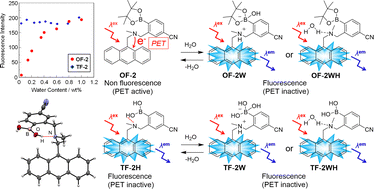Elucidation of a detection mechanism of a fluorescent sensor based on photo-induced electron transfer for water†
Abstract
In order to elucidate a detection mechanism of a photo-induced electron transfer (PET)-type fluorescent sensor for water, we have synthesized anthracene-(aminomethyl)-4-cyanophenylboronic acid (AminoMeCNPhenylB(OH)2) TF-2 by the deprotection of pinacol ester (Pin) of anthracene-AminoMeCNPhenylBPin OF-2. For OF-2, the PET takes place from the nitrogen atom of the amino moiety to the photoexcited fluorophore (anthracene) skeleton in the absence of water, leading to fluorescence quenching (PET active state). When water was added to the OF-2 solution, a drastic enhancement of the fluorescence emission is observed due to the formation of the PET inactive (fluorescent) species OF-2W or OF-2WH by interaction with water molecules which has been determined by 1H NMR spectral measurements. On the other hand, even in the absence of water TF-2 exhibits intense fluorescence emission and addition of water to the TF-2 solution shows a negligible change in the fluorescence intensity. The 1H NMR spectra of the TF-2 solution without the addition of water clearly indicated the formation of the PET inactive (fluorescent) species TF-2H by the intramolecular OH⋯N hydrogen bonding between the hydroxyl group of the B(OH)2 moiety and the nitrogen atom of the amino moiety. For TF-2, single-crystal X-ray structural analysis as well as density functional theory (DFT) calculations revealed the existence of the intramolecular OH⋯N hydrogen bonding, that is, the formation of TF-2H. Interestingly, the 1H NMR spectra of the TF-2 solution with the addition of water showed the existence of the PET inactive (fluorescent) species TF-2W or TF-2WH by interaction with water molecules, as with the case of OF-2. Consequently, it was found that for the PET-type fluorescent sensor based on the anthracene-AminoMeCNPhenylBPin structure, the BPin moiety is essential not only to activate the PET in the absence of water, leading to fluorescence quenching, but also to form the PET inactive (fluorescent) species upon the addition of water. This work provides a direction in molecular design toward creating an effective PET-type fluorescent sensor for water as well as a conclusive detection mechanism of the anthracene-AminoMeCNPhenylBPin structure for water.



 Please wait while we load your content...
Please wait while we load your content...